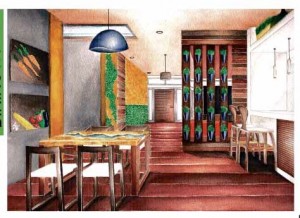‘Green-ness’ marks winning entries in design contest
MANILA, Philippines–A University of San Carlos (USC Cebu) student, who incorporated a garden in her design of the interiors of an imaginary home, is the first Filipino winner for interior design in the Nippon Paint Young Designer Award (NPYDA).
Kristine Caballes, who received P50,000 for her winning entry, also got an additional P5,000 when her design was named Best Green Innovation. Caballes’ design impressed the judges so much she got a rating of more than 90 percent while the runner-up got less than 80 percent.
Jason B. Labacanacruz of Technological University of the Philippines (TUP Manila) won the gold and P50,000 as the first Filipino winner in the architecture category of NPYDA.
He also received P5,000 for winning the prize for Best Color Choice.
Aside from the cash prize and trophy, the winners will each receive a six-month internship at Lor Calma & Partners and a fully paid trip in March to Osaka, Japan, to compete with the winners from Malaysia, Vietnam, Thailand, Singapore, Indonesia, Pakistan, China, Japan and Hong Kong for the regional title.
Article continues after this advertisementThey will also participate in the Japan Learning Program, an exclusive workshop for NPYDA winners that will feature internationally renowned architects and interior designers as speakers and resource persons.
Article continues after this advertisementUSC Interior Design professor Adrian del Monte, Caballes’ adviser, and TUP Architecture professor Elpidio Balais, Jr., Labacanacruz’s adviser, each received P10,000. The winners’ schools each got P10,000 in cash and P10,000 worth of paint voucher.
NPYDA was launched in 2008 but was brought to the Philippines only last year. The competition’s theme was “Re: Think. Re: Create. Our Community, Our Home.”
Silver awardees were Jestefanie Tanchuling of the University of Santo Tomas (UST) for interior design and Lloyd Hopanda of Eulogio “Amang” Rodriguez Institute of Science and Technology (EARIST Manila) for architecture, each receiving P30,000 in cash. Tanchuling received an additional P5,000 for winning the Best Color Choice.
In architecture, Arian Sustento of Adamson University (Manila) received P5,000 for winning the Best Green Innovation award.
Gladys Goh, group general manager of Nippon Paint Malaysia Group, said “the exceptionally talented young people” who participated in the competition represented the future of design. The first NPYDA drew 120 entries in interior design and 76 in architecture.
Goh said she was impressed that they got so many entries in just about six months since they launched NPYDA in the Philippines. She added that the competition was not just about “looking pretty,” as it put emphasis on the green element. The contest criteria assigned 30 percent of the total score to “green-ness.”
“All entries were very unique and relevant to the needs of the Philippines and inspired by the Philippines’ natural wonders,” she said. Nippon Paint invested in the competition, she said, “because what’s the use of having green technology if there is no green design?”
Rogelio Caringal, president of the Philippine Institute of Interior Design, said NPYDA was “planting the seeds of green consciousness for better, greener and healthier environment.”
Beth Regala, president of United Architects of the Philippines, said architects played a critical role in shaping the environment, while Rolando Cordero, chair of the Professional Regulation Commission Board for Architecture, who chaired the board of judges, said the NPYDA confirmed his view that there was an abundance of talent among young Filipino interior designers and architects.
Caballes said her design was guided by the Philippine climate, geography and everything about the country. In her design statement, she said “people living in this residence can save energy, water and money by using rainwater as their source of energy and water supply.”
She incorporated rain catchment facilities and a vertical wall garden with hydroponics plants, which do not use soil as planting material.
Scenes of devastation and death caused by recent typhoons, Labacanacruz said, led him to think of a design that would minimize the destructive impact of natural and other calamities. His entry, “Indayog ng Kulay Housing Project,” uses, among other things, recycled cargo containers to reduce the use of natural construction materials.
The other eight finalists in each category of the Philippines’ first NPYDA competition received P10,000 each. They were:
Interior design—Liana Bianca Limjoco, UST; Stacy Mae Chan, USC Cebu; April Jan Molino, UST; Hannah Marie Betonio, USC Cebu; Mark John Acoba, Philippine Women’s University Manila; Syril Jendryl Clemente, UST; Kristel Anne Poyaoan, University of the Philippines Diliman (UP Diliman); and Raiza Gangoso, La Consolacion College Bacolod.
Architecture—Roldan Lopeña, National University (NU Manila); Jose Laserna Jr., EARIST Manila; Niel Gardonia, NU Manila; Rod Kevin Gonzales, UP Diliman; Rewin John F. Corpuz, Tarlac State University (TSU); Jan Nicole Dizon, TSU; and Daisy Antonio, TUP Manila.


